The sight of brightly coloured butterflies dancing across of a garden or feeding from flowers is always a welcome sign.
Butterflies and moths are indicators of the health of our ecosystem, as recognised by the Government, and it’s critical that we do what we can to save them from further decline and extinction.
Here are some facts about these beautiful winged creatures, in our expert guide by Butterfly Conservation:
How many species of butterflies and moths are there in the UK?
There are 59 species of butterflies seen regularly in the UK. 57 of these are resident species whereas two, the painted lady (pictured below) and the clouded yellow, are regular migrants that breed here every summer.

Meanwhile, there are over 2,500 species of moths. These are typically split into the ‘macro’ (large) and ‘micro’ (small) moths, but there are some micro moths that are quite large and vice versa!
How many species have gone extinct in the UK?
Four species of butterflies are classified as extinct in the UK, and half of Britain’s remaining butterfly species are now on the Red List of British butterflies, meaning they are threatened or near threatened with extinction.
However, thanks to the work of Butterfly Conservation, along with partner organisations, the large blue butterfly has been successfully reintroduced, and the chequered skipper butterfly has recently been reintroduced to England.
51 moth species have been lost from Britain since 1900 and a further three species may also now be extinct.
Learn more about reintroductions in the UK:
Are any UK butterfly and moth species endangered?
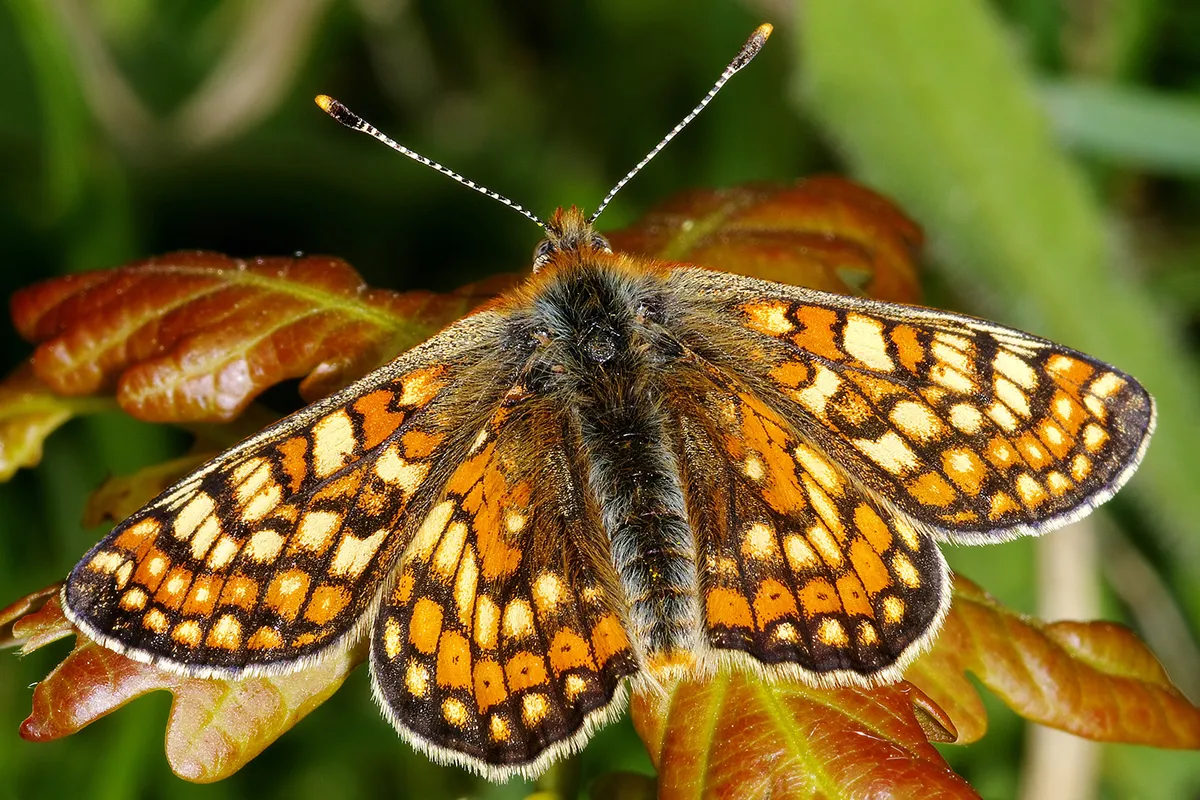
Half of Britain’s remaining butterfly species are on the Red List, and the extinction risk is increasing for more species than it is decreasing for.
A recent report from Butterfly Conservation showed there to be a 26% increase in the number of species threatened with extinction since 2011
Moth numbers are also decreasing. The State of Britain’s Larger Moths Report 2021 showed a worrying 33% decline in the populations of larger moths in Britain in the last 50 years.
55 species of larger moth are classified as threatened in Britain and an additional 58 are near threatened on the Red List.
Are any butterflies of moths species protected?
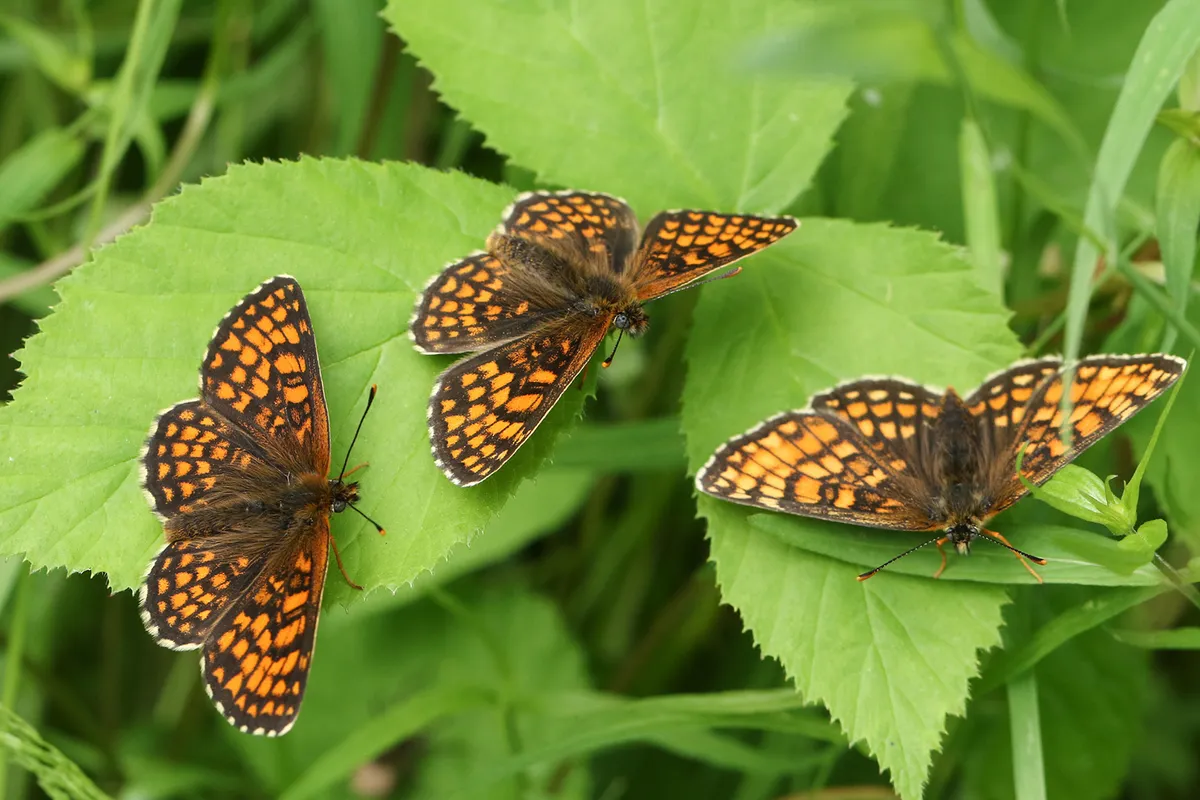
The butterflies and moths listed below are specially protected under the Wildlife & Countryside Act 1981 and it is illegal to catch, handle or harm them without a license.
Butterflies:
- Heath fritillary (Melitaea athalia)
- High brown fritillary (Fabriciana adippe)
- Large blue (Phengaris arion)
- Large copper (Lycaena dispar)
- Marsh fritillary (Euphydryas aurinia)
- Swallowtail (Papilio machaon)
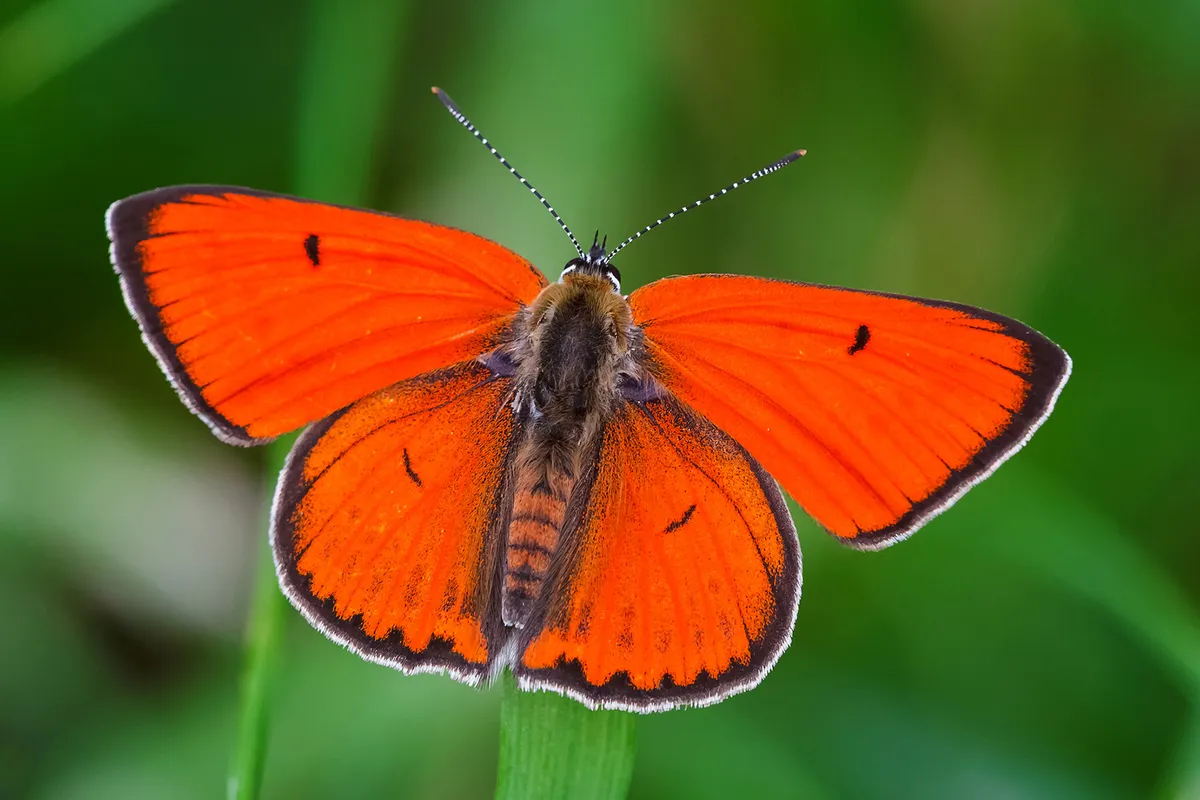
Moths:
- Barberry carpet (Pareulype berberata)
- Black-veined (Siona lineata)
- Essex emerald (Thetidia smaragdaria)
- Fiery clearwing (Bembecia chrysidiformis)
- Fisher's estuarine moth (Gortyna borelii)
- New Forest burnet (Zygaena viciae)
- Reddish buff (Acosmetia caliginosa)
- Sussex emerald (Thalera fimbrialis)
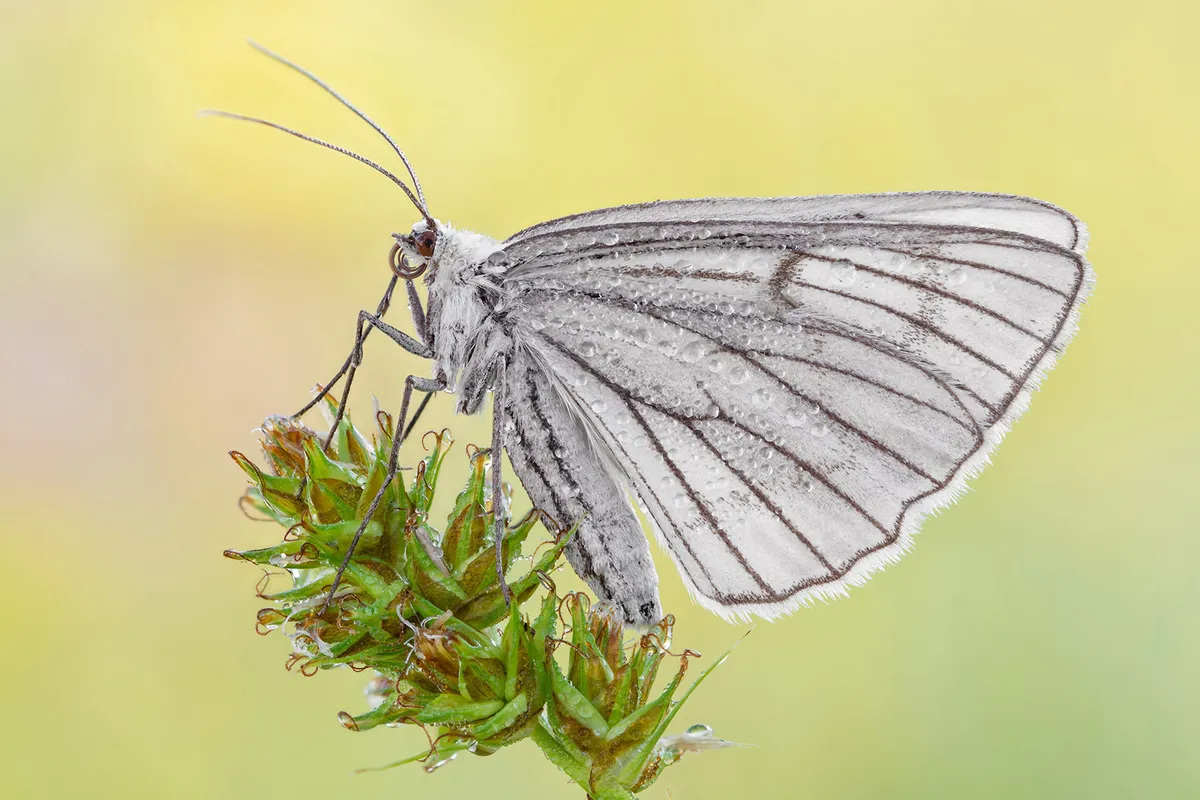
What is being done to help butterflies and moths?
Butterfly Conservation works on projects across the UK to protect and conserve some of the most threatened butterflies and moths, and the landscapes they inhabit.
We also currently have over 30 nature reserves which act as sanctuaries for butterflies, moths and other wildlife and we are involved in over 70 landscape-scale projects to conserve habitats.
This is especially important as many species of butterfly and moth rely on specific habitats.
Butterfly Conservation also has strong ties with a wide range of organisations. Working closely with Natural England we have recently successfully boosted the numbers of Duke of Burgundy, a threatened species, in Kent.

Two projects here, that have since been taken over and run by volunteers, have involved continuous conservation management over 25 years and ensured an 185% increase in sightings across 13 colonies from the last recorded year in 2020.
While the main focus is on preventing extinction and reversing historical declines, where necessary, Butterfly Conservation works to reintroduce species that have been lost.
The chequered skipper (Carterocephalus palaemon), for example has recently been reintroduced to a landscape in England, after being extinct in the country for more than 40 years.
You can read more about Butterfly Conservation’s 2021-2026 Strategy to save butterflies and moths here.
How to submit records of butterflies and moths
Butterfly Conservation runs a variety of different projects for recording butterflies and moths so there are options to suite everyone, irrespective of your level of experience or the amount of time you have available.
The Big Butterfly Count is an annual citizen science event that everyone can take part in. All you need to do is spend 15 minutes outside in any sunny spot and count the amount and types of common butterflies you see.
This year’s Big Butterfly Count is running from 15th July to 7th August 2022.
With its focus only on the most widespread species, Big Butterfly Count is perfect for beginners as well as more experienced wildlife watchers. To submit your counts, you can download the free app or go to the website here.

To record species year-round, or those species that aren’t part of the Big Butterfly Count, you can submit sightings online or use the free iRecord Butterflies app.
This guides you through the identification of any butterfly you see in the UK and adds your sightings to millions of other valuable records that inform the work of Butterfly Conservation.
If you are particularly interested in recording butterflies in your garden, then the Garden Butterfly Survey is for you.
Moth records can be added to the National Moth Recording Scheme.
More citizen science projects to take part in:
Common species of butterfly in the UK
Brimstone butterfly (Gonepteryx rhamni)

The brimstone butterfly is one of the first species to be seen each year, as they overwinter as adults. The bright yellow-green of the male is unmistakeable, even in flight. The female is white-green.
This species' distribution is limited by its food plants – buckthorn and alder buckthorn. It is found in England, Wales and Ireland, with occasional sightings in southern Scotland.
Brimstones can be seen all year round, but peak times are April and May, and then July and August.
Orange-tip butterfly (Anthocharis caradmines)
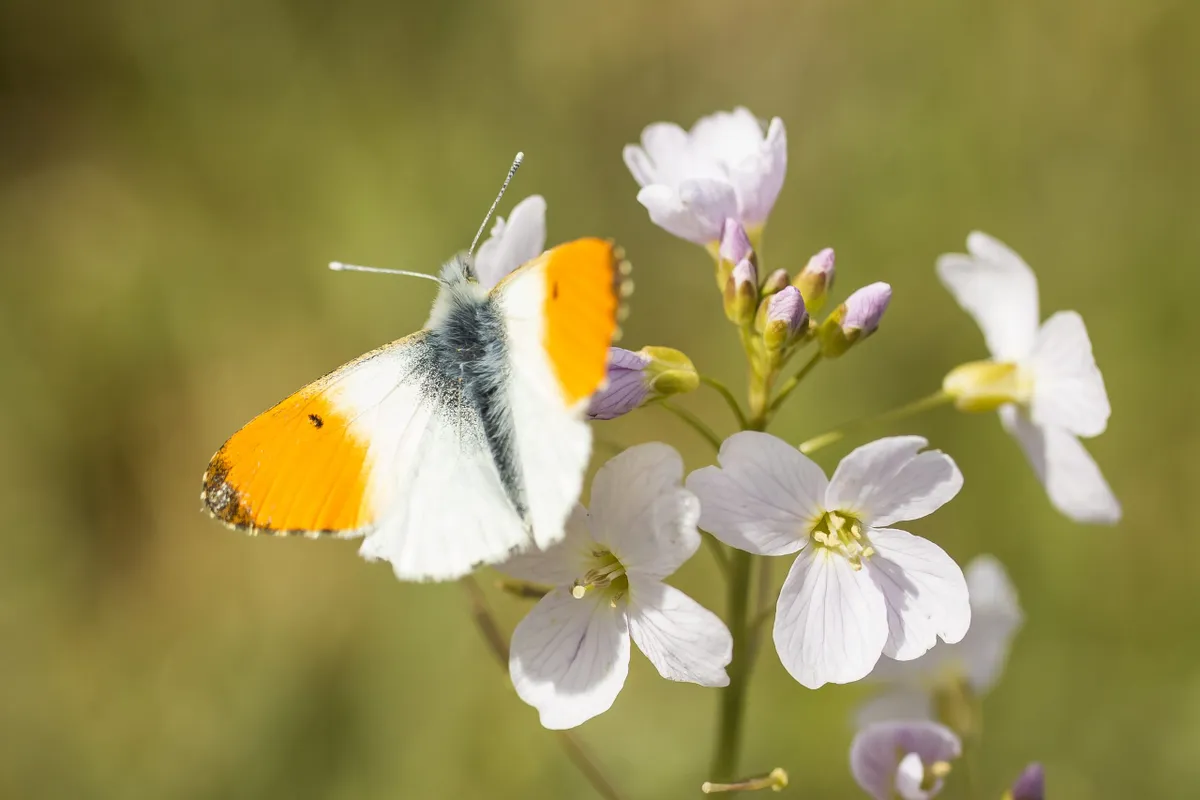
The orange-tip butterfly is so-named because of the orange tips on the forewings of the male butterfly. At a glance, the female can look similar to some other white butterflies, but the key to identifying her is to look at the underside of her hind wings which is a patchwork of green and white. Both male and female orange-tips have this patterning on the underside of their hind wings.
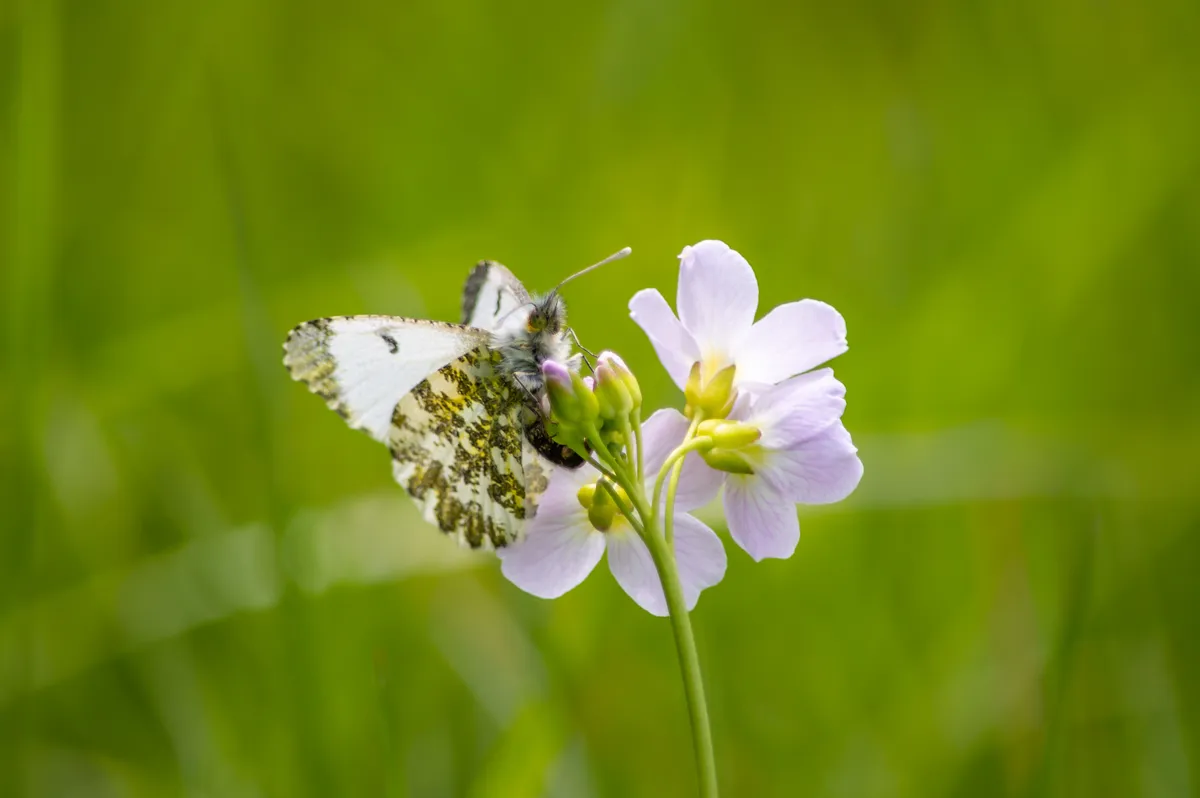
Orange-tip butterflies are one of the signs that spring is truly underway, as they are among the first of the species which emerge from their pupae.
They are found across the UK and Ireland, and can be found in a variety of habitats, including some gardens.
Large white butterfly (Pieris brassicae)
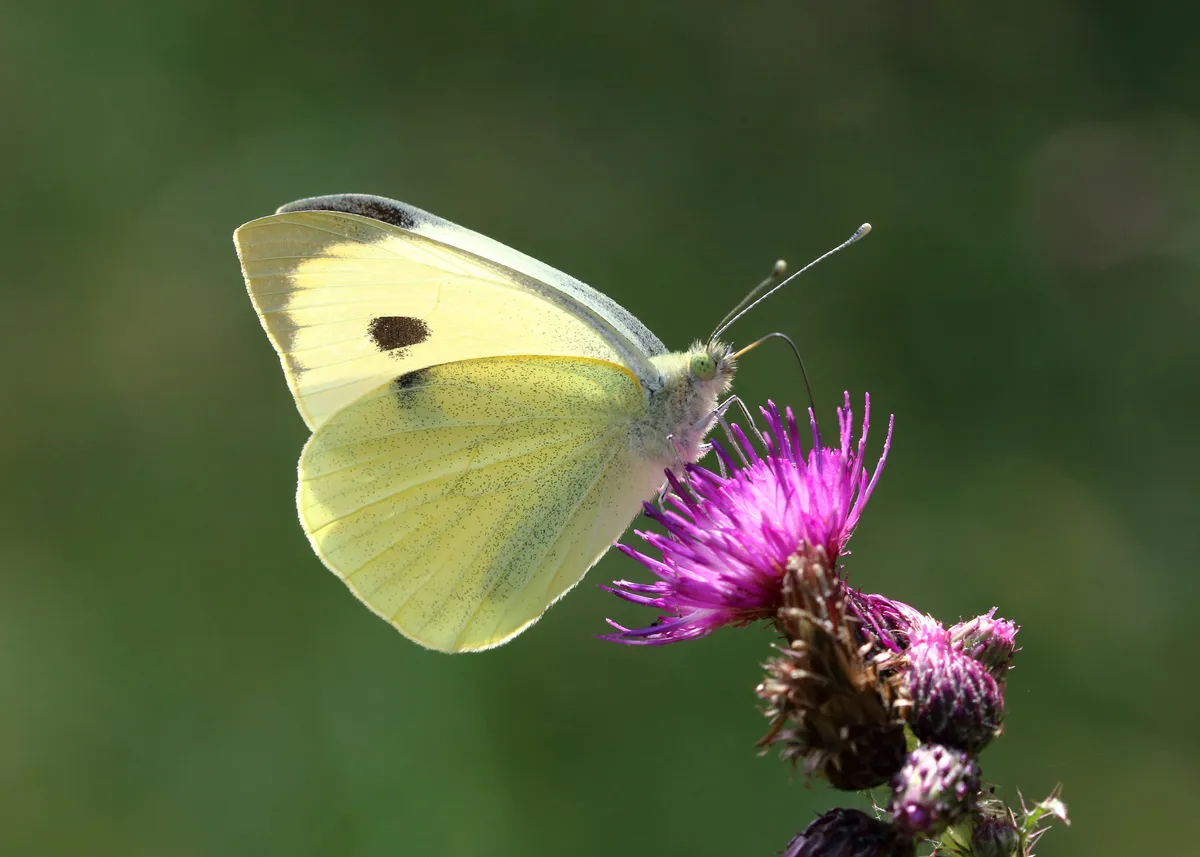
Despite the name, the large white butterfly isn't always that much larger than the small white butterfly (below), and the two are often known as 'cabbage whites'.
There are two broods of the large white butterfly. The first adults emerge from their pupae in April, and the second brood emerges in July. They can be found in a wide variety of habitats, and the caterpillars are considered pests by some gardeners that grow plants in the Brassicae family.
Small white butterfly (Pieris rapae)

The small white butterfly is very similar in appearance to the large white butterfly (above), and is also known as a cabbage white – however the caterpillars are less destructive to Brassicae plants.
Like the large white, it is found across a huge variety of habitats, and the first brood emerges mid April, followed by the second brood in late June and July.
Green-veined white butterfly (Pieris napi)
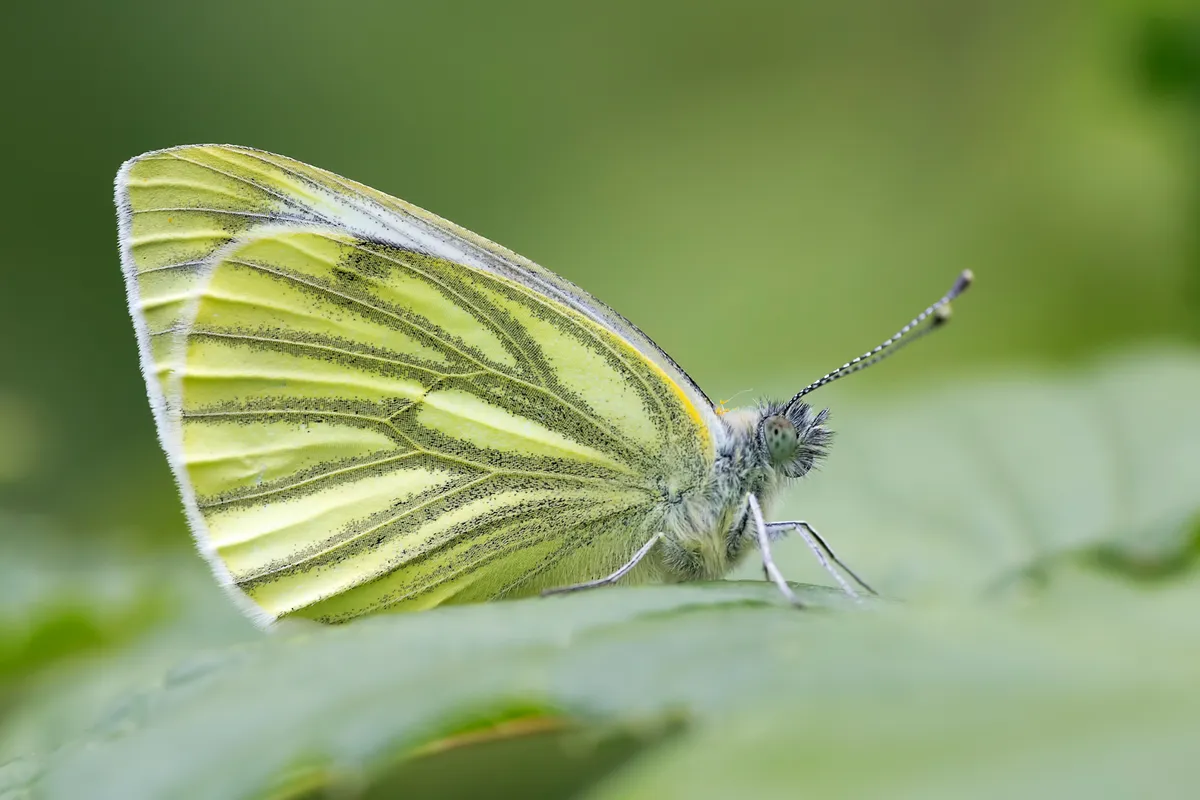
Although the upper sides of the green-veined white look very similar to the large and small whites, a glimpse of the underside of its wings will show the green veins that it is named after.
Found across the UK, the first adults emerge from mid-April in the southern part of the country, with the second brood emerging from July.
Red admiral butterfly (Vanessa atalanta)

Red admiral butterflies can be seen all year round, as they hibernate during winter as adults. They are among the first of the species that can be seen flying as spring arrives.
The UK population is supplemented by migrating butterflies from Europe. With their distinctive black wings, red lines and white spots, this species is one of the easiest butterflies to identify – although it can be confused for a peacock butterfly in flight as both are large with dark underwings.
Painted lady butterfly (Vanessa cardui)

One of our visiting migratory species, the painted lady can sometimes arrive in huge numbers, and can be seen anywhere in the UK and Ireland.
Adults are usually seen from late March and April onwards, until about September or October. They mate and produce at least one more generation here, which then leaves the UK and Ireland to return to Northern Africa and Arabia.
Peacock butterfly (Aglais io)
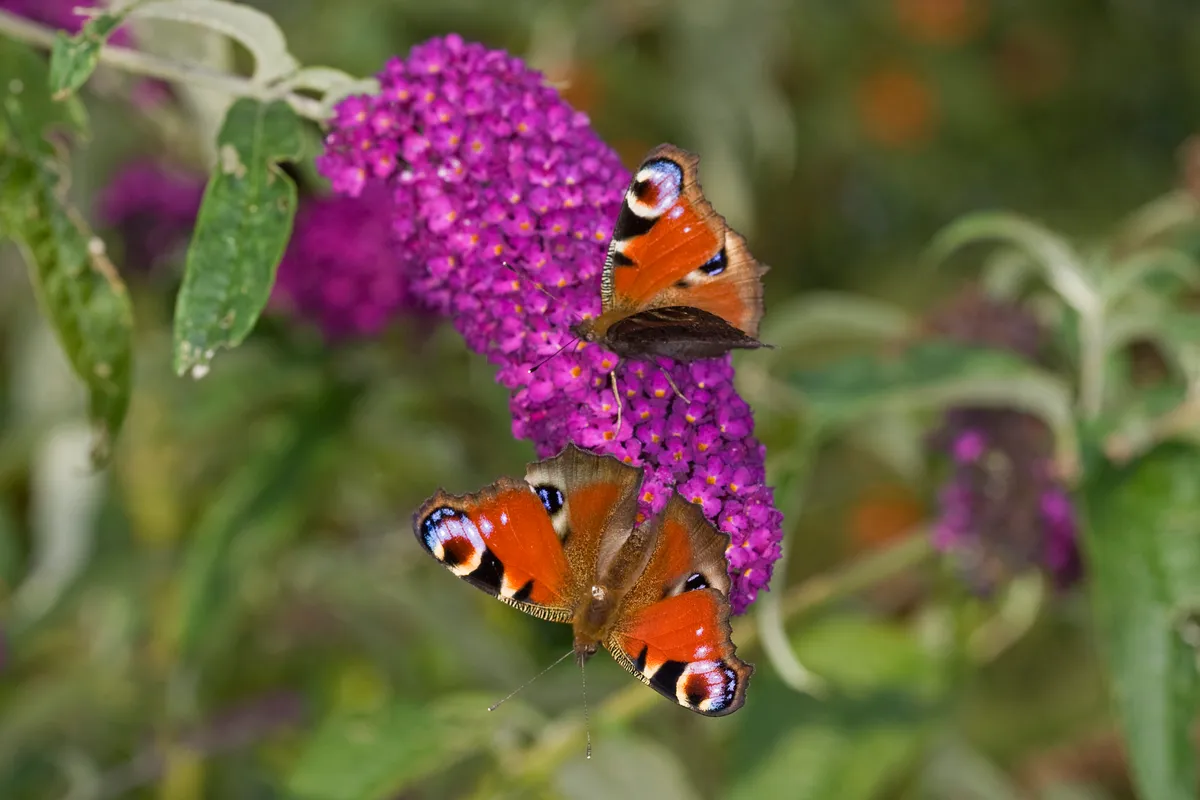
The peacock's bold red colour and four 'eyes' on its wings make it unmistakable (unless the wings are closed, in which case it could be confused with a red admiral or small tortoiseshell). When deterring predators, it will flash its wings to show its eyes and even create a hissing sound.
This is another species that hibernates as an adult, and is common across the UK and Ireland in a variety of habitats.
Small tortoiseshell butterfly (Aglais urticae)
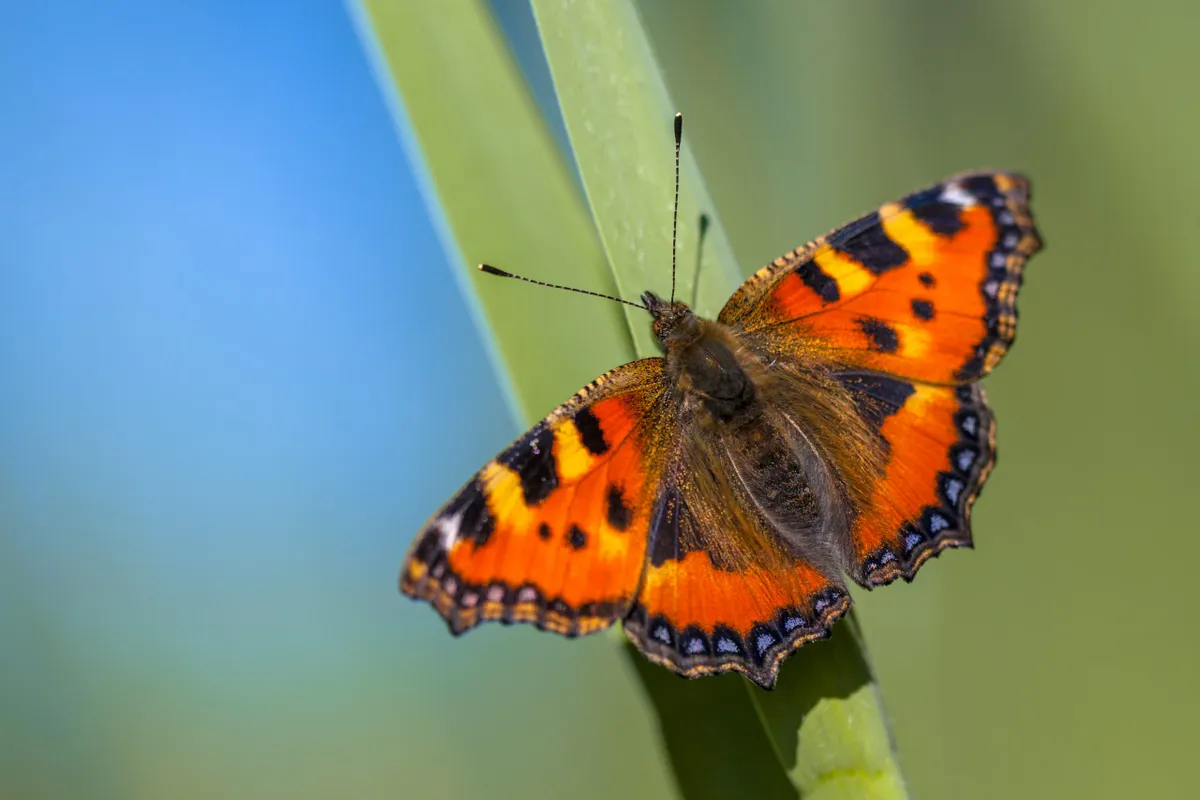
The small tortoiseshell butterfly could be mistaken for a painted lady (above) or comma butterfly (below), so look out for the blue markings at the edge of the wings and the alternate pattern along the leading edge of the forewings.
This is another species that can be seen very early in the year due to hibernating as an adult. It is found across all of the UK and Ireland, and in a wide range of habitats.
The UK is occasionally visited by large tortoiseshell butterflies, which are very similar in appearance.
Comma butterfly (Polygonia c-album)

The comma butterfly is named after the little white comma-shaped mark on the underside of its hindwing, though this can be hard to spot. It's ragged wing edges make it very distinctive, though once other orange butterflies species age and become worn, they could also have slightly ragged wing edges.
It hibernates as an adult, and can be seen for much of the year. Widespread in England and Wales, it is less common in Scotland and Ireland.
Meadow brown butterfly (Maniola jurtina)
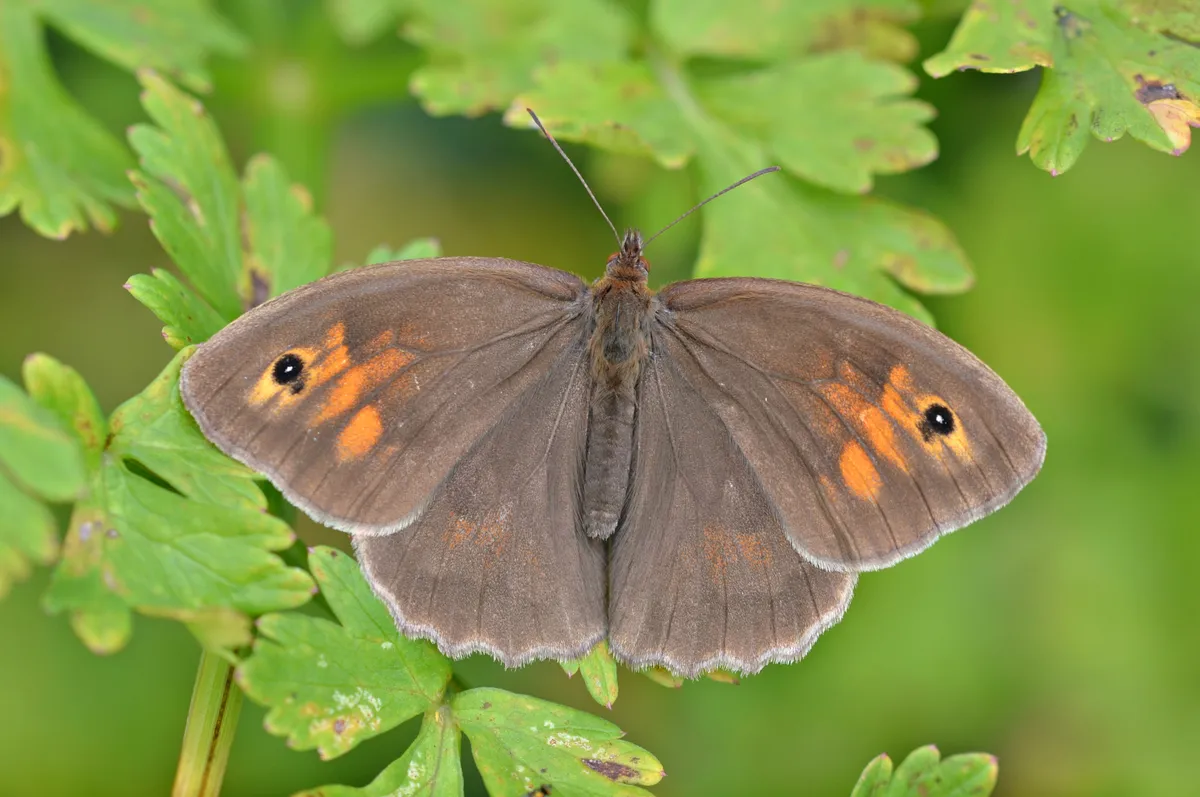
One of the most abundant butterfly species in many habitats, the meadow brown butterfly has some orange on the upper side of it forewings around a black dot. The underside of the forewings also orange colouration.
The meadow brown can be seen in a range of habitats from meadows to riverbanks or hedgerows and will fly even in dull weather.
Speckled wood butterfly (Pararge aegeria)

The speckled wood butterfly can also be seen in all four countries across the UK. As the name would suggest, it has yellow speckles on its brown wings and can be seen flying in shaded woodland, as well as gardens and hedgerows. You might see the males resting in sunny spots, spiralling into the air to chase each other.
Unlike other butterfly species, the speckled wood is rarely seen feeding from flowers. Instead, it mainly feeds on honeydew in treetops.
Common blue butterfly (Polyommatus icarus)
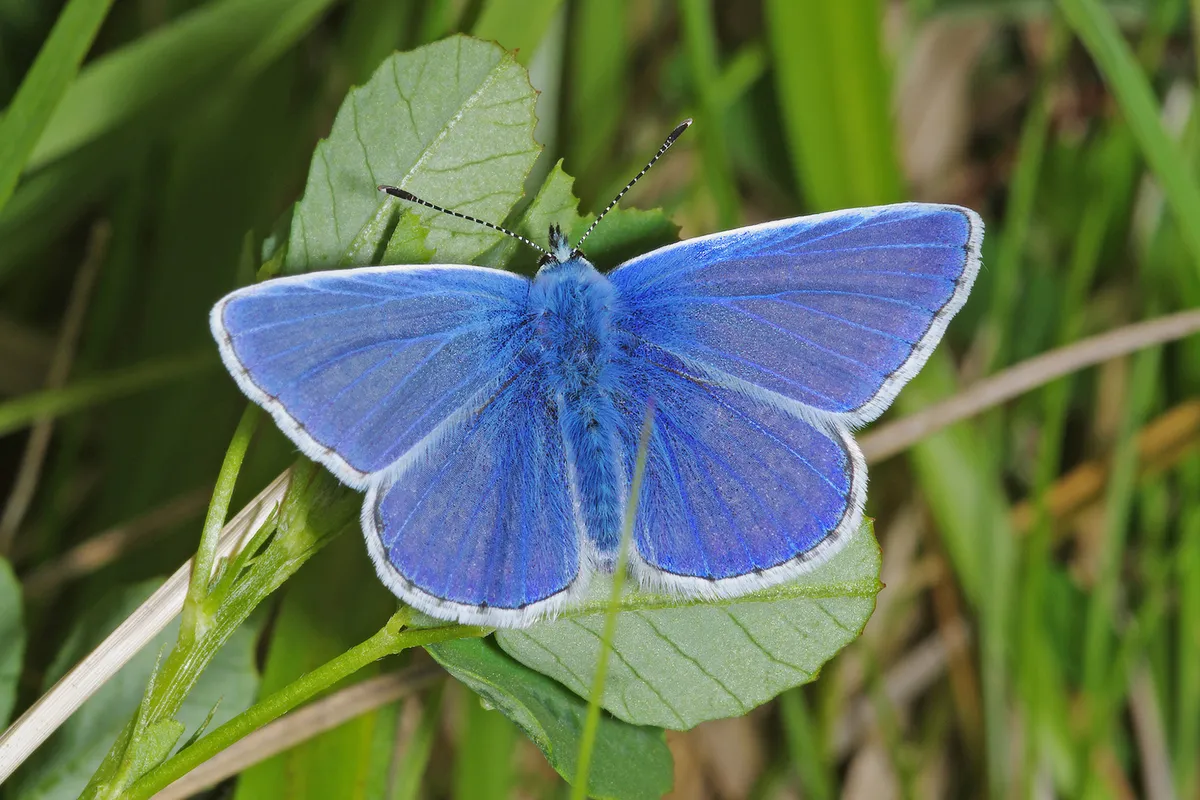
Likewise, the common blue butterfly is also spread across England, Northern Ireland, Scotland, and Wales – it is the most widespread of the blue butterfly species and can be seen in a range of locations including more urban sites like cemeteries.
The male (which is blue upperwings) can be separated from the adonis and chalk hill blue butterflies by the dark veins not extending into the white fringes of the wing margins. The female (which has brown upperwings) can be easily confused with the brown argus butterfly.
Rare species of butterfly in the UK
Swallowtail butterfly (Papilio machaon)

A large and spectacular species, the swallowtail butterfly has pale yellow wings, with dark veins and blue margins, with red spots at the rear of its hind wings.
The UK subspecies of the swallowtail butterfly (P. m. britannicus) is our only resident species in the Papilionidae family, and is restricted to just the Norfolk Broads. This is partly due to the distribution of the milk-parsley, which is the only plant that the swallowtail butterfly caterpillar feeds on.
Occasionally, adults from the continental subspecies are reported as having flown over. These sightings typically come from the southern part of country, including Hampshire, Sussex, Kent and Buckinghamshire.
Chequered skipper butterfly (Carterocephalus palaemon)

Like the other skippers, this is a small and fast-flying butterfly which is easy to lose track of. It can be distinguished from other skipper butterflies by its wing markings, with yellow and brown colouration to give a chequered appearance.
Until recently, the chequered skipper butterfly could only be seen at a few sites in north-west Scotland, but it has been reintroduced to the Rockingham Forest in Northamptonshire with butterflies from Belgium.
Large blue butterfly (Phengaris arion)
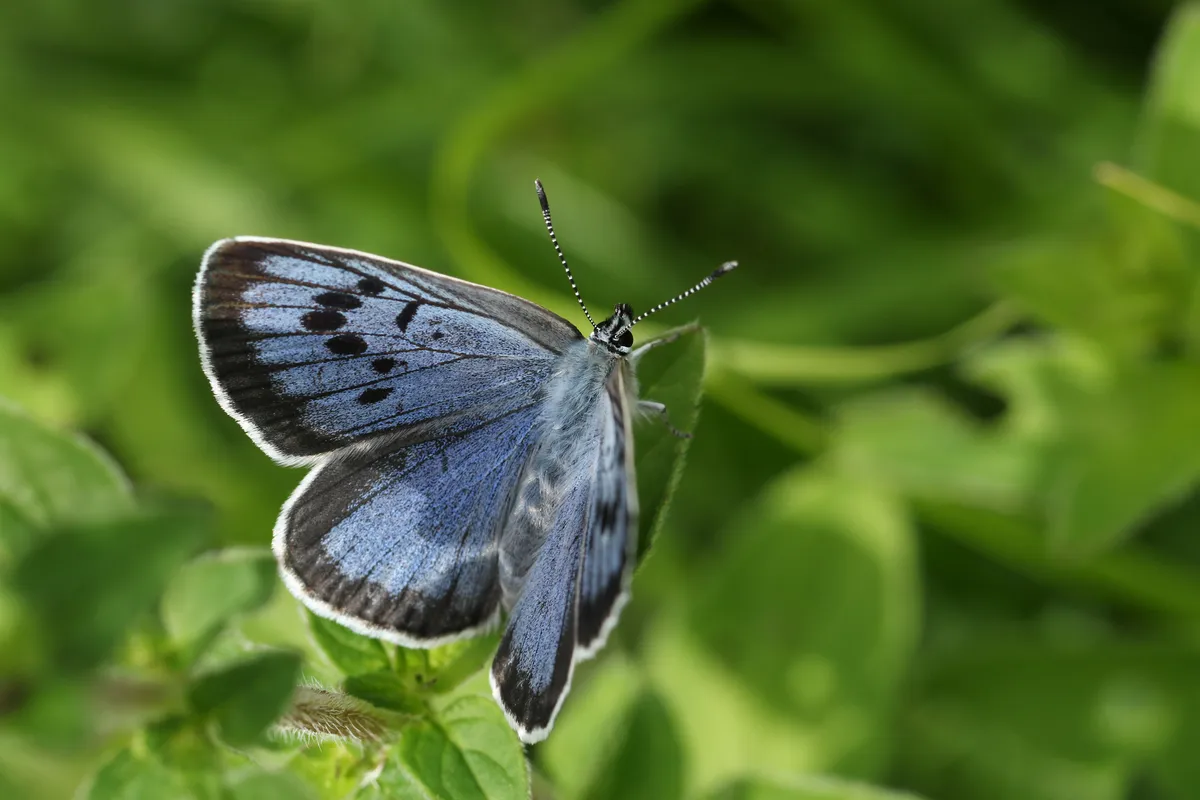
Despite its name, the large blue butterfly is surprisingly small, with a maximum wingspan of just 44mm! However, it is actually the largest of the blue butterfly species in the UK – and the rarest. The species actually went extinct in Britain in 1979, but was reintroduced from continental Europe at a few locations in the south-west of England.
Like some other blues, the larvae of the large blue butterfly has a relationship with Myrmica red ants, where the ants end up taking a fourth instar larva into their nest – where it then feeds on ant grubs.
The species is declining across much of its worldwide range, and is endangered globally.
High brown fritillary butterfly (Argynnis adippe)

A large and impressive orange butterfly with a wingspan of up to 67mm, the high brown fritillary was once widespread in England and Wales but has undergone a dramatic decline since the 1950s and can only be found on around 50 sites.
At these locations, it can be seen flying swiftly over the tops of bracken or low vegetation in woodland clearings. In flight, the males are almost impossible to separate from those of the dark green fritillary, which often share the same habitats. However, both species frequently visit flowers such as thistles and bramble where it is possible to see their distinctive underside wing markings. The dark green lacks the orange ringed 'pearls' on the underside of the hindwing.
Main image: Heath fritillary butterflies perching on seeding grass. © Sandra Standbridge/Getty
